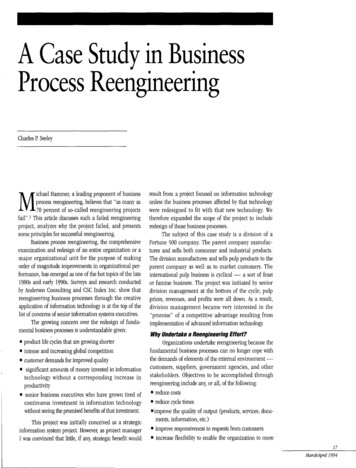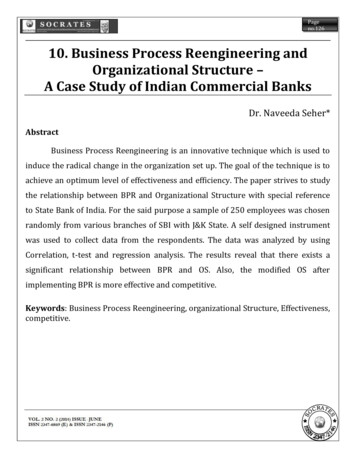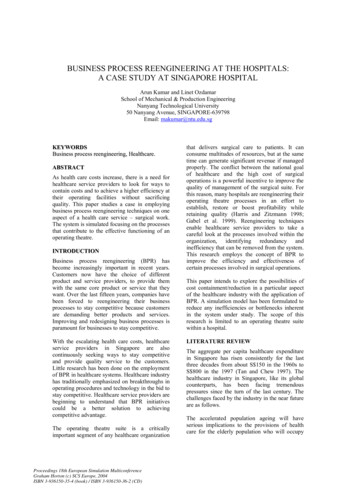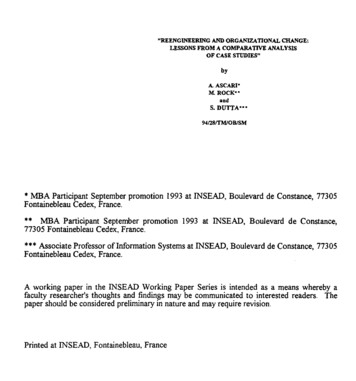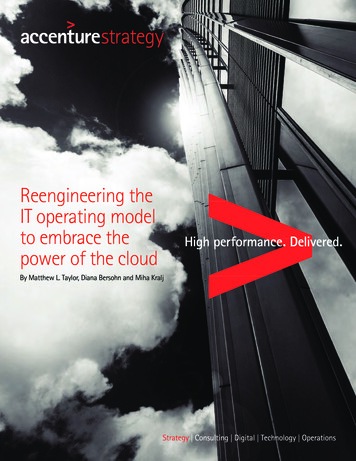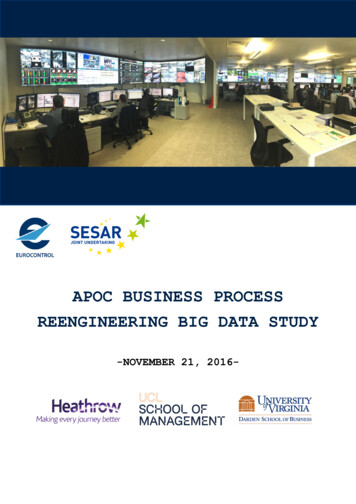
Transcription
––––APOC BUSINESS PROCESSREENGINEERING BIG DATA STUDY-NOVEMBER 21, 2016-
authorsUCL School of Management, University College LondonBert De Reyck – bdereyck@ucl.ac.ukXiaojia Guo – x.guo.11@ucl.ac.ukDarden School of Business, University of VirginiaYael Grushka-Cockayne – GrushkaY@darden.virginia.eduKenneth C. Lichtendahl Jr. – LichtendahlC@darden.virginia.eduAndrey Karasev – andreyjet@gmail.comHeathrow AirportTom Garside – Tom Garside@heathrow.comNeville Coss – Neville Coss supplier@heathrow.comFrederick Tasker – Frederick Tasker@heathrow.com
ABSTRACTImproving airport performance is at the heart of the SESAR’s Airport Operations Centre(APOC) solution. By providing access to real-time data from various data sources ofdifferent APOC stakeholders, airports can make accurate predictions about theiroperations, including passenger movements. In this study, we review APOC roles andresponsibilities, identify the key APOC processes that could be enhanced by data-drivenpredictions and machine learning techniques (DDP&ML), and demonstrate a case study ofhow shared data and advanced analytics can be used to make predictions of passengers’connection times. In the case study, a regression tree model is fitted to a large training setwith 3.7 million passenger records. This predictive model is applied to generate forecasts(together with prediction intervals) of each passenger’s connection time and the passengerflows during an eight-hour live trial. The real-time predictions generated by the model couldbe used to inform Target-Off-Block Time (TOBT) adjustments and determine transfersecurity resourcing levels.
CONTENTS1.INTRODUCTION.- 4 -2.APOC OVERVIEW .- 6 -2.1 Purpose of APOC, Roles and Key Decision Processes . - 6 2.2 Data Sources . - 9 2.3 Frame and Identify Selected DDP&ML Activity . - 9 3.THE TRANSFER PASSENGER PROBLEM .- 11 -3.1 Heathrow Transfer Passenger Journey . - 11 3.2 Problem Framing . - 12 4.THE PREDICTIVE MODEL .- 15 -4.1 Data Collection . - 16 4.2 Training the Model . - 18 4.3 Generating Forecasts from the Model . - 22 4.4 Accuracy Assessment and Discussion . - 26 4.5 Retraining the Model. - 29 5.LIVE TRIAL AND ASSESSMENTS .- 30 -5.1 Real-time Input Data . - 30 5.2 The Live Trial . - 30 5.3 Discussion . - 33 6.PRESCRIPTIVE ANALYSIS .- 35 -6.1 TOBT Adjustment According to Passenger Delays . - 35 6.2 Security Lane Resourcing . - 37 6.3 Inter-Terminal Coach Frequency and Routing . - 38 7.CONCLUSIONS AND FUTURE WORK.- 39 --1-
7.1 Conclusions . - 39 7.2 Future Work. - 40 APPENDIX A: GLOSSARY .- 42 APPENDIX B: REFERENCES .- 43 APPENDIX C: INTEGRATED PLAN ON ITO AND CONNECTING PASSENGERFLOWS – AN EXAMPLE DAY FOR TERMINAL 5.- 44 APPENDIX D: DCPFP SYSTEM ARCHITECTURE .- 45 APPENDIX E: DESCRIOTIONS OF THE 47 PASSENGER SEGMENTS .- 54 --2-
Figures and TablesFigure 1. APOC Roles and Airport Interfaces.-6Figure 2. The Heathrow Connection Passenger Journey.- 11 Figure 3. The DMAC system.- 13 Figure 4. Key Process to be Predicted and the Available Data Sets.- 13 Figure 5. System Architecture.- 15 Figure 6. Data Consolidation.- 17 Figure 7. Performance of Decision Trees with Different Tuning Parameters and Features.- 19 Figure 8. The Regression Tree Model for Predicting Passengers' Connection Times.- 20 Figure 9. Predictors of the Model and Their Feature Importance.- 21 Figure 10. Distributions of the Instances Fall into Each Leaf.- 22 Figure 11. Examples of the Output Files.- 24 Figure 12. Predictions of the 15 min Connecting Passenger Flows from June 7 to 13, 2016.- 27 Figure 13. Interface of the Connection Time Forecasting Application.- 30 Figure 14. Example of Running Trials with a 2 hours Forecasting Window and a 5 minutes UpdatingFrequency.- 31 Figure 15. Example of Passenger Flow Predictions Generated by the Application.- 32 Figure 16. Assessing the Live Trial in the APOC Room.- 32 Figure 17. Real-time Monitoring of the T5 Flight Connection Area.- 33 Figure 18. PTM Timing Analysis of July 17th.- 34 Figure 19. An Example of the Improvement on TOBT Predictability.- 36 Figure 20. System Architecture.- 45 Figure 21. Examples of the BOSS, BDD and Conformance Data sets.- 44 Figure 22. Data Consolidation.- 47 Figure 23. Distributions of the Instances Fall into Eachl Leaf.- 49 Figure 24. Output Files Generated by Running the Application.- 53 -Table 1. Data Sources.- 10 Table 2. Accuracy of Forecasts from the Regression Tree Model (RT) and Benchmark Method. - 28 Table 3. Hit Rates of the 80% Prediction Intervals for the 1-min and 5-min passenger flows.- 29 Table 4. Information of Passengers Connecting to Flight BA74.- 36 Table 5. Summaries of the BOSS, BDD, and Conformance Data.- 46 --3-
1.INTRODUCTIONThe Airport Operation Centre (APOC) has been defined in SESAR (Single European SkyATM Research) and developed by major European Airports 1 . The APOC consolidatesdifferent stakeholders in a physical or virtual operations room where existing airportoperations applications, such as gate management, de-icing, security, baggage, passengerprocesses and crisis management, are managed in a collaborative manner.The APOC has been viewed as the principle support to all major airport decision-makingprocesses. In support of these processes, different stakeholders in the centre integrateinformation from commonly shared data sets, develop dynamically joint plans, and executeplans that are within their respective area of responsibility. In their current form, existingprocesses in APOC have been formalized and are supported by Airport CollaborativeDecision Making (A-CDM). There remains scope for a strategic assessment of APOCprocesses and further leveraging the power of operational data.The main purposes of this project is threefold. First, to review the APOC processes. Second,to identify key processes that could be enhanced by data-driven predictions and bymachine learning algorithms (DDP&ML). And finally, to provide a case study to illustratehow shared data and advanced analytics can be used to increase the benefits from anAPOC. This project has been undertaken in Heathrow’s APOC, arguably the mostadvanced APOC in Europe.Heathrow airport, the largest UK airport, carries over 70 million passengers each year toover 250 destinations worldwide2. The airport community employs over 70,000 people andoperates collaboratively with over 200 stakeholder organizations. In 2015, airport trafficincreased by 2.2% to 75 million passengers, with an average load factor of 76.5% 3 .Heathrow’s APOC went live on November 12th, 2014. The vision was to house theadvanced support systems and processes to enable the deployment of the SESAR AirportOperations Management concept. One year on, Heathrow’s APOC has become the nervecentre of all CDM processes between stakeholders, capturing the benefits of closecollaborations, planning, real-time monitoring, proactive decision making and flowmanagement.Heathrow is the only international hub in the UK, and the vast majority of the flights landingor departing from Heathrow have at least 25% transfer passengers. With so many transfersrequired, it is critical that the processes involved in the connecting journey are optimized to1Eurocontrol, 2010Heathrow Airport Limited, 2015a3Heathrow Airport Limited, 2015b2-4-
ensure Heathrow’s vision to ‘give passengers the best airport service in the world’4. Betterpredictions of passengers’ transfer activities may also improve the accuracy and stability ofthe Target-Off-Block Time (TOBT), one of the most important parameters in airport’splanning processes. In addition, the APOC has the ability to improve passengers’experience of the connection journey. Therefore, enhancing related data-intensive analyticsactivity is worth exploring.This study begins with a general overview of Heathrow’s APOC processes. We characterizethe typical APOC roles and responsibilities, focusing on the key decision processes of theflow managers. We also identify the processes that could benefit from making better use ofdata.Based on data availability and the importance of the problem, we decided to focus thesecond half of the study on improving the processes related to connecting passenger’sactivity. Specifically, we develop a prototype model using the regression tree method toforecast transferring passengers’ connection times at Heathrow. This model is built on 3.7million passenger records collected from three datasets: the Business Objective SearchSystem (BOSS) dataset, the Baggage Daily Download (BDD) dataset, and theConformance dataset. To generate real-time predictions from the model, we developed anapplication using Python. Three outputs are provided by running the application: (1) themean and quantiles of the passengers’ connection times; (2) expected number of latepassengers for each outbound flight with its current TOBT and delayed TOBTs; (3) themean and quantiles of the transfer passenger flow at the Conformance desk.In addition to providing accurate forecasts, our model can support APOC decision-makingprocesses in three additional ways. First, the regression tree model is helpful for the flowmanagers who are interested in understanding the key factors that influence passengers’connection times. Second, the TOBT of an outbound flight could be adjusted according tothe predictions of the number of late passengers. Third, these forecasts would allow APOCto make better transfer security lane plans.Finally, we ran an 8-hour live trial at Heathrow’s APOC to test the feasibility and impact ofour model in real time. During the live trial, we generated 2-hour window predictions everyfive minutes. The trial was successful and the model reveled the potential to better managepassenger flows, with a link to improving TOBT predictability and stability.The remainder of the report is organized as follows. Section 2 will present an overview ofAPOC processes. In Section 3 we will provide the framing of the transfer passengerproblem. In Section 4, we will elaborate on the predictive model for forecasting transferpassengers’ connection times. In Section 5, we will describe the live trial of the predictivemodel and report the accuracy of the predictions generated during the trial. In Section 6, wewill discuss several decision making processes that could be enhanced by our predictivemodel. Finally, Section 6 will summarize the project and propose future researchopportunities4Heathrow Airport Limited, 2015.-5-
2.2.1APOC OVERVIEWPurpose of APOC, Roles and Key Decision ProcessesThe APOC consists of a variety of airport teams, with the common goal of ensuring ‘Happypassengers, travelling on time, with their bags’. In support of the various decision-making processes,different stakeholders integrate information from commonly shared data sets to develop integratedplans and execute those plans within their respective areas of responsibility.Roles within the APOC include the airport operations manager (AOM), aircraft flow manager, securityflow manager, passenger flow manager, operations lead coordinator, engineering help centre advisor,airport control engineer and baggage service manager (BSM). The APOC roles and their interactionsare shown in Figure 2.In this subsection, we will focus on the key decision processes of the passenger flow manager, thesecurity flow manager and the aircraft flow manager that allow APOC to influence the passengerjourney. We assume as part of this study that the passengers will not be delayed by their bags. Inmost cases it is assumed that the connection time of the bag is faster than the passenger in all butexceptional cases, or that a baggage expedite process support their transfer.Figure 15. APOC Roles and Airport Interfaces.5Heathrow document. Provided by Heathrow Integrated Planning and Performance Team.-6-
Passenger Flow ManagerThe passenger flow manager sits in the APOC and monitors the flow of passengers throughHeathrow’s terminals. They work with terminal-based operations to deploy resources and optimizethe passenger experience.ObjectivesThe objective of a passenger flow manager is to reduce delay minutes with an efficient use ofresources. On
APOC BUSINESS PROCESS REENGINEERING BIG DATA STUDY -NOVEMBER 21, 2016- UCL School of Management, University College London Bert De Reyck – bdereyck@ucl.ac.uk Xiaojia Guo – x.guo.11@ucl.ac.uk Darden School of Business, University of Virginia Yael Grushka-Cockayne – GrushkaY@darden.virginia.edu Kenneth C. Lichtendahl Jr. – LichtendahlC@darden.virginia.edu
